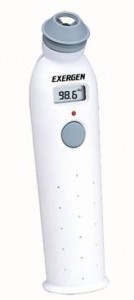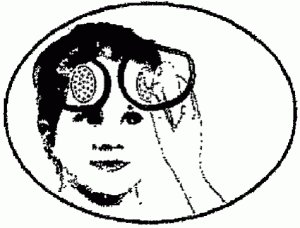Exergen sued Wal-Mart, CVS, and several thermometer makers (including SAAT) for infringement of three patents covering infrared detecting thermometers. The U.S. Court of Appeals for the Federal Circuit ruled that one of the patents was invalid because it is inherently anticipated, and the other two were not infringed. See Exergen, Corp. v. Wal Mart Stores.
The thermometers measure the emitted infrared radiation off a human body to get the surface temperature. Typical measurement points are the eardrum and the forehead. The body’s internal temperature is then calculated from the surface temperature and displayed on the digital readout of the thermometer.

The District court construed that “biological surface tissue” means “a living layer of external human tissue having a temperature that can be measured,” and that “internal temperature” means the “temperature of the region existing beneath the surface of the biological tissue targeted for measurement.”
At the jury trial, SAAT was found to have willfully infringed two of the patents and actively induced infringement of the third, with damages totaling more that $2.5 million. SAAT moved for JMOL, and Exergen moved for enhanced damages. Both were denied, both appealed.
SAAT challenged the jury finding that the ‘205 patent was not anticipated by U.S. Patent No. 4,602,642 (“O’Hara”). The independent claim of ‘205 recites:
1. A method of detecting temperature of biological tissue comprising: providing a radiation detector for sensing infrared radiation from an external target; sensing radiation from multiple areas of the biological tissue with the radiation detector; and electronically detecting the peak radiation from the multiple areas to obtain a peak temperature signal.
The O’Hara reference discloses a thermometer handheld probe unit that is used to sense infrared emissions from the ear canal. When the unit is removed from the base (chopper unit), it takes radiation measurements seven times per second, storing the maximum reading. After the SCAN button is pressed, the maximum reading from the moment the unit was removed from the base is displayed. Exergen argued that O’Hara only measures radiation from one location, not multiple ones as required by the claims. Unfortunately, Exergen’s own expert testified that O’Hara inherently anticipates this limitation:
Q. While you’re moving this probe unit from the chopper unit, is it — what is it measuring?
A. It’s measuring infrared radiation.
Q. And you have to move it along the side of the patient’s face to get to the ear, don’t you?
A. Yes.
Q. During the period that you’re moving along the side of the patient’s face, what’s it measuring? What’s it doing?
A. It’s measuring radiation.
A user of O’Hara’s thermometer would measure radiation from the patient’s face, outer ear, and inner ear at a rate of seven times per second, inherently sensing radiation from multiple areas and anticipating Exergen’s claim.
SAAT also challenged the jury’s finding of direct infringement of the ‘813 patent. The claim which was found to be infringed was:
7. A radiation detector comprising:
- a thermopile mounted to view a target of biological surface tissue;
- a temperature sensor for sensing ambient temperature;
- an electronic circuit coupled to the thermopile and temperature sensor and responsive to the voltage across the thermopile and the temperature sensed by the sensor to provide an indication of an internal temperature within the biological tissue adjusted for the ambient temperature to which the surface tissue is exposed; and
- a display for providing an indication of the internal temperature.
SAAT argued that their thermometer, which targets the forehead, did not display an internal temperature, but an oral temperature. Exergen tried to alter the construed meaning of “internal temperature” to include an oral temperature, but had to retract it. The court was not too pleased with how Exergen’s counsel interpreted the record or the court’s ruling, suggesting that if Exergen had won this case, their counsel might have so prejudiced SAAT as to warrant a new trial.
For a hat trick, SAAT challenged the jury’s finding of induced infringement of the ‘685 patent. Claim 1 of the patent reads:
1. A method of detecting human body temperature comprising: laterally scanning a temperature detector across a forehead; and providing a peak temperature reading from plural readings during the step of scanning.
The instructions for the thermometers included a drawing (the two circles were added during the trial):
The instruction state to scan the thermometer around the temple area, or to slowly slide upwards. SAAT argues that neither of these instructions, nor the drawing would induce a user to slide the thermometer laterally across the forehead. Exergen creatively compares lateral scanning to crossing the Charles river. Whether you are crossing it going east, west, north, or south you are still crossing it. The point of these instructions is to find the temporal artery. The Federal Circuit disagreed. Exergen expressly waived the doctrine of equivalents before trial. “Under a theory of literal infringement, to which Exergen was limited, no reasonable jury could have found that scanning within an oval pattern in the temple region on one side of the forehead meets the literal requirement of scanning ‘across a forehead.’”
In a similar way, the Federal Circuit looked at the literal meaning of claim 27, which reads:
27. A method of detecting human body temperature comprising measuring temperature of the temporal artery through skin.
The SAAT thermometer only reads the surface temperature of the skin which covers the temporal artery, not the actual temperature of the temporal artery. The court agreed.
Today’s post comes from Guest Barista Scott Conley, a registered patent agent in Frost Brown Todd’s Cincinnati office.

